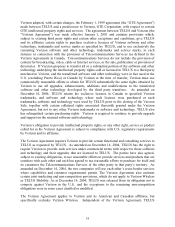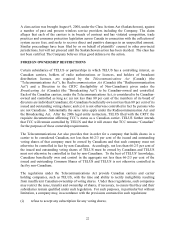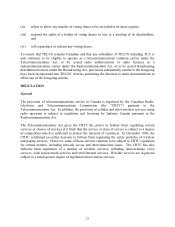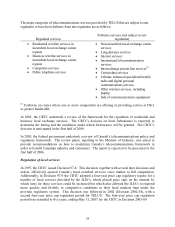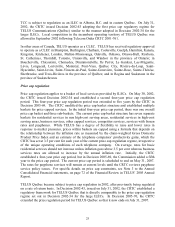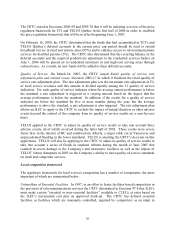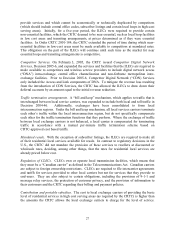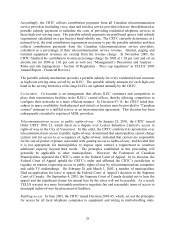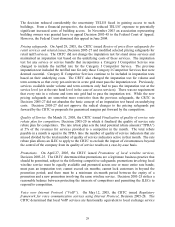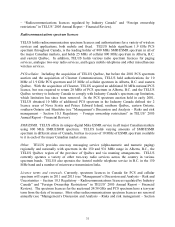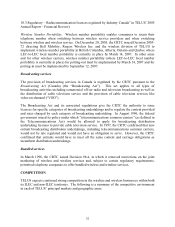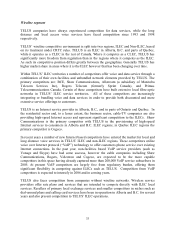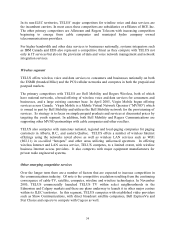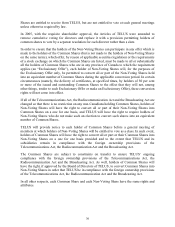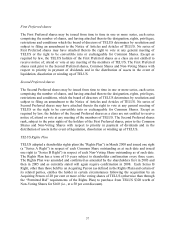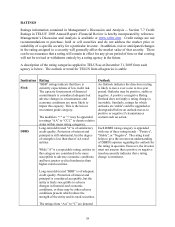Telus 2005 Annual Report Download - page 29
Download and view the complete annual report
Please find page 29 of the 2005 Telus annual report below. You can navigate through the pages in the report by either clicking on the pages listed below, or by using the keyword search tool below to find specific information within the annual report. 28
Accordingly, the CRTC collects contribution payments from all Canadian telecommunication
service providers (including voice, data and wireless service providers) that are then disbursed as
portable subsidy payments to subsidize the costs of providing residential telephone services in
these high-cost serving areas. The portable subsidy payments are paid based upon a total subsidy
requirement calculated on a per line/per band subsidy rate. The CRTC currently determines, at a
national level, the total contribution requirement necessary to pay the portable subsidies and then
collects contribution payments from the Canadian telecommunication service providers,
calculated as a percentage of their telecommunication service revenue. Internet, paging and
terminal equipment revenues are exempt from the revenue charge. In November 2005, the
CRTC finalized the contribution revenue percentage charge for 2005 at 1.03 per cent and set an
interim rate for 2006 at 1.03 per cent as well (see “Management’s Discussion and Analysis –
Risks and risk management – Section 10 Regulatory – Price cap regulation” in TELUS’ 2005
Annual Report – Financial Review).
The portable subsidy mechanism provides a portable subsidy for every residential local customer
in high-cost serving areas served by an ILEC. The portable subsidy amounts for each high-cost
band in the serving territories of the large ILECs are updated annually by the CRTC.
Co-location. Co-location is an arrangement that allows ILEC customers and competitors to
place their transmission facilities in the ILECs’ central offices, thereby allowing competitors to
configure their networks in a more efficient manner. In Decision 97-15, the CRTC ruled that,
subject to space availability, both physical and virtual co-location must be provided to “Canadian
carriers” pursuant to a tariffed service or an interconnection agreement. This decision has been
subsequently extended to registered ADSL providers.
Telecommunications access to public rights-of-way. On January 25, 2001, the CRTC issued
Order CRTC 2001-23, which ruled on a dispute over Ledcor Industries Limited’s access to
rights-of-way in the City of Vancouver. In this order, the CRTC confirmed its jurisdiction over
telecommunications access to public rights-of-way; determined that municipalities cannot charge
carriers rent for access to, or occupancy of, rights-of-way; indicated that carriers are responsible
for the out-of-pocket expenses associated with gaining access to rights-of-way; and decided that
it is not appropriate for municipalities to impose upon carriers a requirement to construct
additional capacity beyond their needs. The principles established in this proceeding will
generally be applicable to other municipalities. However, the Federation of Canadian
Municipalities appealed the CRTC’s order to the Federal Court of Appeal. In its decision, the
Federal Court of Appeal upheld the CRTC’s order and affirmed the CRTC’s jurisdiction to
regulate on matters respecting access to public rights-of-way by telecommunications companies
and cable-TV undertakings. On February 28 and March 3, 2003, a number of municipalities
filed an application for leave to appeal the Federal Court of Appeal’s decision to the Supreme
Court of Canada. On September 4, 2003, the Supreme Court of Canada decided not to hear the
appeal and the significant claims for annual fees by the cities will not be payable. As a result,
TELUS was put in a more favourable position to negotiate fair and reasonable terms of access to
municipal rights-of-way for placement of facilities.
Building access. In June 2003, the CRTC issued Decision 2003-45, which, set out the principles
for access by all local telephone companies to equipment and wiring in multi-dwelling units.


